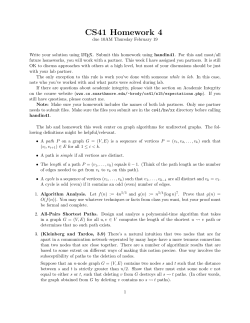
Worksheet 11.5 - Tequesta Trace Middle
Name ——————————————————————— LESSON 11.5 Date ———————————— Study Guide For use with the lesson “Explore Solids” GOAL Identify solids. Vocabulary A polyhedron is a solid that is bounded by polygons, called faces, that enclose a single region of space. An edge of a polyhedron is a line segment formed by the intersection of two faces. A vertex of a polyhedron is a point where three or more edges meet. The bases of a prism are congruent polygons in parallel planes. The base of a pyramid is a polygon. A polyhedron is regular if all of its faces are congruent regular polygons. LESSON 11.5 Theorem 1 Euler’s Theorem: The number of faces (F), vertices (V), and edges (E) of a polyhedron are related by the formula F 1 V 5 E 1 2. A polyhedron is convex if any two points on its surface can be connected by a segment that lies entirely inside or on the polyhedron. Copyright © Houghton Mifflin Harcourt Publishing Company. All rights reserved. A polyhedron is concave if any two points on its surface can be connected by a segment that goes on the outside of the polyhedron. Platonic solids are five regular polyhedra that include the regular tetrahedron, cube, regular octahedron, regular dodecahedron, and regular icosahedron. A cross section is the intersection of a plane and a solid. EXAMPLE 1 Identify and name polyhedra Tell whether the solid is a polyhedron. If it is, name the polyhedron and find the number of faces, vertices, and edges. a. b. c. Solution a. The solid is formed by polygons, so it is a polyhedron. The base is a triangle, so it is a triangular pyramid. It has 4 faces, 4 vertices, and 6 edges. b. The sphere has a curved surface, so it is not a polyhedron. c. The solid is formed by polygons, so it is a polyhedron. The two bases are congruent rectangles, so it is a rectangular prism. It has 6 faces, 8 vertices, and 12 edges. Geometry Chapter Resource Book 11-71 Name ——————————————————————— LESSON 11.5 Date ———————————— Study Guide continued For use with the lesson “Explore Solids” EXAMPLE 2 Use Euler’s Theorem with Platonic solids Find the number of faces, vertices, and edges of the polyhedron. Check your answer using Euler’s Theorem. Solution By counting on the diagram, the tetrahedron has 5 faces, 5 vertices, and 8 edges. Use Euler’s Theorem to check. EXAMPLE 3 Euler’s Theorem Substitute. This is a true statement. So, the solution checks. Describe cross sections Describe the shape formed by the intersection of the plane and the solid. a. b. Solution a. The cross section is a circle. b. The cross section is a pentagon. Exercises for Examples 1, 2, and 3 Tell whether the solid is a polyhedron. If it is, name the polyhedron and find the number of faces, vertices, and edges. 1. 2. 3. 4. Find the number of faces, vertices, and edges of the polyhedron. Check your answer using Euler’s Theorem. Describe the shape formed by the intersection of the plane and solid. 5. 11-72 Geometry Chapter Resource Book 6. 7. Copyright © Houghton Mifflin Harcourt Publishing Company. All rights reserved. LESSON 11.5 F1V5E12 5155812 10 5 10
© Copyright 2025












